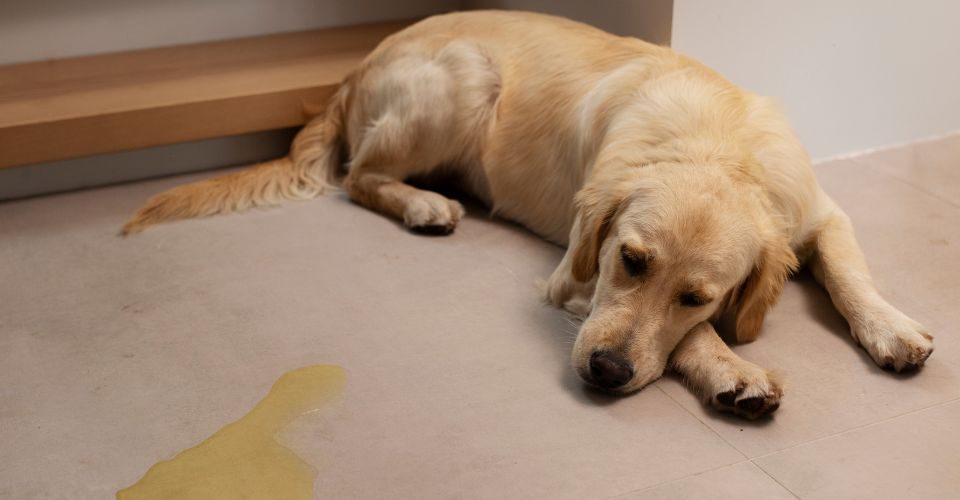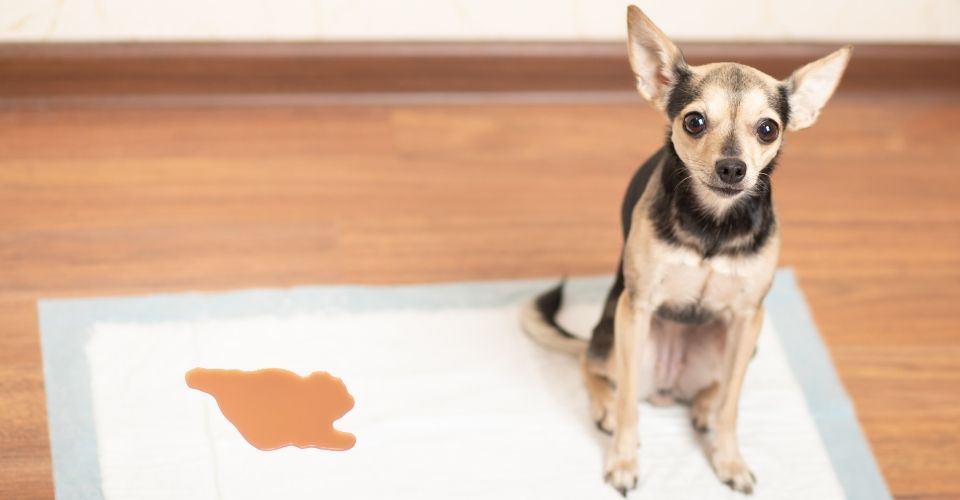As dog owners, we know the joy that our furry companions bring into our lives. Always ready to play and give unconditional love, these special creatures provide unconditional companionship while at the same time keeping us company.
Unfortunately, their habits can sometimes become annoying, such as peeing in the house or outside on the lawn. And if your pup’s urine has ever appeared yellow and you are not clear why, we have the answers!
In this article, we explore several reasons for it being yellow and its health consequences. Let’s get started!
Dog Urine Colors
Understanding the color of your dog’s urine can provide valuable insight into their health. In general, dog urine can range in color from clear to yellow, orange, brown, and even red. Clear urine may indicate over-hydration, while dark brown or red urine could be a sign of a serious health issue.
Orange urine may suggest dehydration, while certain medications or dyes can cause green or blue urine. In the next section, we will focus on yellow urine in dogs, which can be caused by a variety of factors ranging from diet to dehydration to health conditions.
Let’s explore these possible sources in more depth.
Causes of Dark Yellow Urine in Dogs
Before we dive into the potential causes of yellow urine in dogs, it’s important to note that transparent yellow urine is considered normal and healthy for dogs. This color indicates that the dog is well hydrated and their kidneys are functioning properly.
However, if the urine is clear, it may indicate overhydration, which can also be problematic for dogs. On the other hand, if the urine is dark yellow, it may be a sign of an underlying health issue.
Here are some potential causes of dark yellow urine in dogs:
Dehydration
As mentioned earlier, dehydration is a common cause of yellow urine in dogs. If your dog is not drinking enough water or is losing fluids due to illness or exercise, their urine can become concentrated and appear darker in color. To prevent dehydration in dogs, make sure they have access to clean, fresh water at all times, especially during hot weather or after exercise.
Diet
Certain foods can affect the color and odor of a dog’s urine. For example, a diet that is high in protein can make the urine more concentrated and darker in color. Similarly, if your dog consumes foods containing food dyes, their urine may appear yellow or orange. If you suspect your dog’s diet may affect its urine color, consult with your veterinarian about possible dietary changes.
Health Conditions
Several health conditions can cause yellow urine in dogs. For instance, liver disease can cause yellow urine due to a buildup of bilirubin, a waste product produced by the liver. Similarly, if a dog has diabetes, it may produce more urine than normal, which can cause the urine to appear darker and more yellow.
Urinary tract infections, bladder stones, and kidney disease are other potential health conditions that may cause yellow urine in dogs.
Medications
Some medications can cause yellow urine in dogs. For example, antibiotics and painkillers can cause the urine to appear darker and more yellow in color. If you suspect your dog’s medication may affect their urine color, consult your veterinarian about potential side effects.
It’s important to note that dark yellow urine can also be a sign of dehydration, especially if the urine is accompanied by other symptoms such as lethargy, dry mouth, or sunken eyes. If you suspect your dog is dehydrated, offer them water and monitor their symptoms. If the symptoms persist, consult with your veterinarian.
The Importance of Urine Color in Dogs
The color of your dog’s urine offers key signals about your dog’s health and hydration status. Here is a breakdown of what to make of different dog urine colors.
Hydration Status
The color of your dog’s urine can provide important information about their hydration status. Pale yellow (sometimes called transparent yellow) indicates that your dog is well hydrated, while clear urine may indicate overhydration. On the other hand, dark yellow or orange urine may indicate dehydration or other health issues.
When dehydrated, your dog’s urine becomes more concentrated, resulting in a darker color. This can be caused by a variety of factors, including inadequate water intake, excessive sweating, vomiting, diarrhea, and fever. In some cases, dehydration can be a sign of an underlying medical condition, such as kidney disease or diabetes.
Health Issues
Changes in urine color can be one of the first indicators of an underlying health issue. Here are some examples of what different colors of urine may indicate:
Red or Brown Urine – Red or brown urine may indicate the presence of blood or other abnormalities in the urinary tract, which can be a sign of infection, injury, or even cancer. Some common causes of red or brown urine include bladder stones, urinary tract infections, and kidney disease.
Green or Blue Urine – Although rare, green or blue urine may be caused by certain medical conditions or medications. For example, some dogs may develop blue urine as a result of ingesting a chemical called methylene blue, which is used as a stain in certain medical procedures.
Cloudy or Milky Urine – Cloudy or milky urine may indicate a urinary tract infection or other health issues. In some cases, it may simply be a sign that your dog’s urine has a high concentration of minerals or other substances.
Black Urine – While rare, black urine in dogs can be caused by certain medical conditions or medications. For example, dogs with copper-associated liver disease may develop black urine as a result of the buildup of a substance called bilirubin.
Consult with Your Veterinarian
If you notice a sudden or significant change in your dog’s urine color, it’s important to consult your veterinarian immediately. Your veterinarian can perform a urinalysis and other diagnostic tests to determine the underlying cause of the change in color. Depending on the results of these tests, they may recommend additional testing or treatment.
In some cases, changes in urine color may result from medications or supplements your dog is taking. If this is the case, your veterinarian may recommend adjusting the dosage or switching to a different medication.
Tips for Preventing Yellow Urine in Dogs
If you’ve noticed that your dog’s urine is consistently dark yellow, there are several steps you can take to help prevent this issue from occurring.
For example:
Ensure Adequate Hydration
One of the most important steps you can take to prevent yellow urine in dogs is to ensure that your furry friend stays well hydrated. This means providing them with plenty of fresh, clean water throughout the day. You may also want to consider adding wet food to your dog’s diet, as this can help increase their overall water intake.
Avoid Excessive Exercise in Hot Weather
Dogs who engage in excessive exercise or play in hot weather are at increased risk of dehydration, which can cause their urine to become more concentrated and darker in color. To prevent this, ensure your dog has access to shade and plenty of water during outdoor activities, and avoid exercising during the hottest parts of the day.
Monitor Medications and Supplements
Certain medications and supplements can cause changes in urine color in dogs. If your dog takes any medications or supplements, discuss potential side effects with your veterinarian. They may recommend adjusting the dosage or switching to a different medication or supplement.
Regular Veterinary Check-Ups
Regular veterinary check-ups are essential for maintaining your dog’s overall health and catching any potential health issues early on. During these check-ups, your veterinarian can perform routine diagnostic tests to ensure that your dog’s organs are functioning properly, and they can also provide you with advice on how to maintain your dog’s health and wellness.
Proper Nutrition
Proper nutrition is key to keeping your dog healthy and happy. Ensure you’re feeding your dog a well-balanced diet appropriate for their age, size, and activity level. Talk to your veterinarian about any dietary concerns or questions you may have.
Following these tips can help prevent yellow urine in dogs and promote overall health and wellness. If you notice any changes in your dog’s urine color, it’s important to consult with your veterinarian to determine the underlying cause and receive appropriate treatment.
Why Is My Dogs Pee So Yellow? Concluding Thoughts
To sum everything up, the color of your dog’s urine can provide valuable information about their health and well-being. While pale yellow urine is normal and indicates sufficient hydration, consistently dark yellow urine can be a sign of dehydration, diet, or underlying health conditions. Monitoring your dog’s urine color and seeking veterinary care if you notice any significant changes is important.






